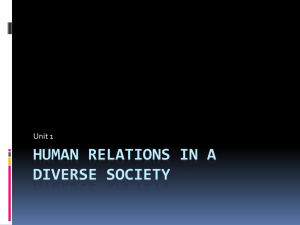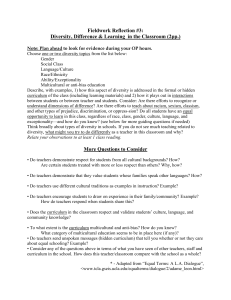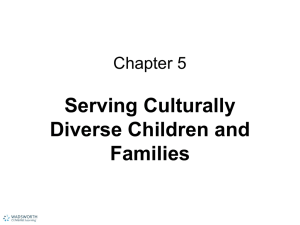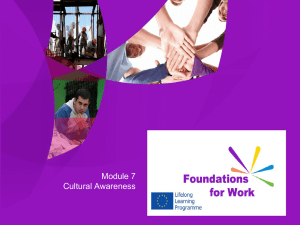Chapter Three Multicultural Classroom
advertisement
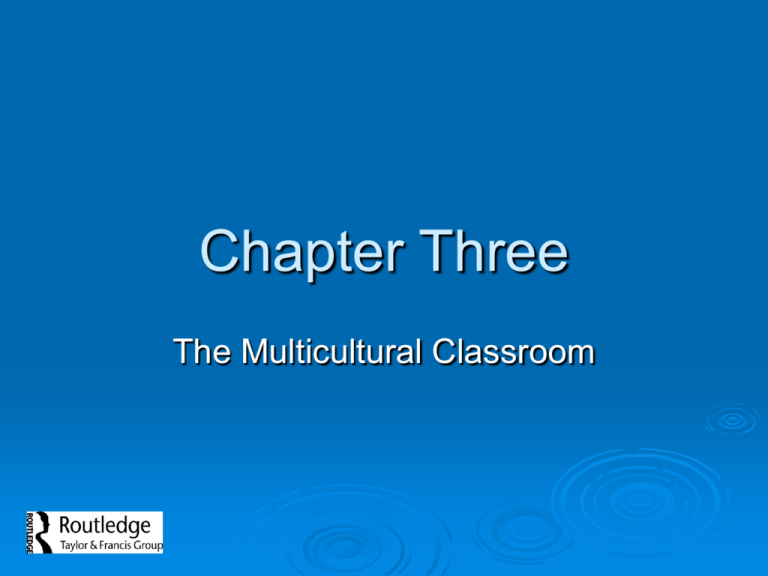
Chapter Three The Multicultural Classroom The Multicultural Curriculum Teachers can help to overcome superficial differences to create a multicultural, democratic society. The new curriculum will consist of a wide variety of teaching strategies that embrace the diverse cultures in the classroom. Teachers will determine bias and carefully monitor all students in the classroom to assure that diversity is valued. Creating a Multicultural Classroom Use multicultural books and materials Show an appreciation of cultural, racial, and ethnic differences Avoid stereotypes Acknowledge differences in children Discover the diversity within the classroom (know your students and their backgrounds) Accept and embrace all of your students Challenging the Status Quo: Subcultures in the Classroom Gender Race Class Religion/culture Other Subcultures Exceptionalities Gender While there are physical differences between men and women, most are the result of environment. Early researchers reinforced prejudices because they found significant differences between boys’ and girls’ standardized math, verbal, and spatial skills examinations. Recent research has demonstrated that these measured differences are beginning to disappear. Promoting Gender Equality In the past, some teachers “bought into” gender stereotypes and assumed that boys had a “natural” superiority in subjects such as math and science. Young boys were “called on” first to answer questions in class and given verbal and nonverbal encouragement. As teachers we need to recognize the powerful role we play in the classroom, and avoid gender stereotyping. This will promote a classroom environment that encourages both males and females to excel and participate in all subjects. Race and Ethnicity Racial and ethnic prejudice emerges as a result of power relationships that develop as part of the socialization process. As young people grow they often establish personal identity by excluding others who are not like them. This sense of “otherness” can lead to feelings of either domination or submission. The “Cycle of Poverty” Many racial and ethnic minority children live in poverty. These children often accept the beliefs and values of the dominant white society including negative stereotypes about themselves. They have little access to quality education that limits their employment options, which in turn leads to more poverty and hopelessness. Breaking the Cycle of Poverty American teachers must create a classroom of inclusiveness. Teachers need to help students develop an appreciation of diversity. By teaching students to value the histories of all people and their cultures, we will achieve the goal of democratic classrooms and help all children learn and succeed. Class As children begin to mature, they often recognize differences in the class position (or family income) of their schoolmates. Individuals from working-class or even lowermiddle-class families may be discriminated against. Researchers have shown that nearly two million people living below the poverty line work full time. Like sexism and racism, classism can be a potent form of exclusion, ridicule, and prejudice. Minimizing the Effects of Classism American teachers can minimize classism by the selection of curricular materials and in their own actions in the classroom. Carefully choose reading materials that emphasize the accomplishments of working class or poor people. Make positive historical references to the labor struggles of working people. Lead frank discussions about the power of advertising and the shallowness of material obsession. Never refer to poor people as “lower class.” Religion and Culture Prejudice based on religion and culture is often subtle and guarded. Its impact can be just as potent in excluding individuals from the “in group” or making individuals vulnerable to ridicule. Religious and cultural preferences may be virtually invisible in the classroom during most of the school year, but can appear during holiday celebrations. Minimizing Religious and Cultural Prejudice Include content from all cultures, both ethnic and religious, into the curriculum. Show interest and enthusiasm about the diverse cultures represented in your classroom. Discuss various cultures in an engaging way. Other Subcultures: Geography, Community and Lifestyle Differences in speech or dress due to our region or community can be the basis of prejudice in the classroom. Those with different sexual orientations may also be discriminated against. Teachers should demonstrate through their own actions that toleration for different attitudes, behaviors, and lifestyles is essential in our multicultural society. Exceptionalities Since the early 1980s, students with exceptionalities have increasingly been mainstreamed into regular classrooms. Today there are more than 6 million students in the U.S. who are considered “exceptional.” These include individuals identified as mentally retarded, learning disabled, visually or speech impaired, hearing impaired, emotionally or behaviorally disturbed, or physically impaired. Minimizing Prejudice Against Exceptional Children Create a classroom environment that is positive, open and understanding of the problems and possibilities of exceptional children. Remember that exceptional children need love, friendship, acceptance, and a place to learn. Become a positive role model for your students, by exhibiting openness, acceptance and understanding.
